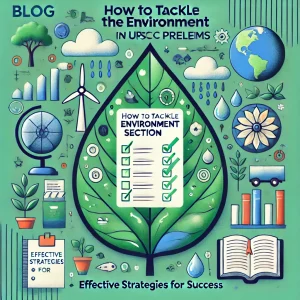How to Tackle the Environment Section in UPSC Prelims
The environment section in the UPSC Prelims has become increasingly significant over the years, with a considerable number of questions being asked from this domain. It is a subject that not only tests your understanding of ecological principles but also your awareness of contemporary environmental issues and global initiatives. To score well in this section, a strategic approach is crucial. Here’s how you can effectively prepare for the environment section in UPSC Prelims.
1. Understanding the Syllabus
Before diving into study materials, it’s important to have a clear understanding of the environment syllabus as prescribed by UPSC. The syllabus broadly covers:
- Ecology and biodiversity
- Environmental conservation
- Climate change and its impacts
- Environmental laws and policies (both national and international)
- Global and national initiatives for environmental protection
Having this clarity helps in directing your study efforts towards the right topics without wasting time on irrelevant content.
2. Focus on NCERTs for Building Basics
The NCERT textbooks from Classes 6 to 12 are your first stop for environment preparation. They provide a foundational understanding of ecological concepts, biodiversity, and environmental issues. Here’s how you can use NCERTs effectively:
- Class 9th and 10th Geography and Science: These books cover basic concepts of environment and ecology.
- Class 12th Biology (Chapters on Ecology): This is essential for understanding ecological principles and biodiversity.
- Class 11th Geography (Chapters on Climate and Vegetation): These chapters give a good understanding of different climatic zones and their vegetation, which is crucial for the environment section.
3. Supplement Your Preparation with Standard Books
Once you’ve covered the basics through NCERTs, it’s time to move on to standard reference books. Some highly recommended books include:
- “Environment” by Shankar IAS: This book is considered the go-to resource for UPSC aspirants. It covers the entire environment syllabus comprehensively and is updated with the latest environmental issues and policies.
- “Certificate Physical and Human Geography” by Goh Cheng Leong: Though primarily a geography book, the sections on climate, weather, and ecosystems are very useful for the environment section.
4. Stay Updated with Current Affairs
Environment-related current affairs are crucial for the UPSC Prelims, as many questions are linked to recent developments and government initiatives. Regularly read newspapers like The Hindu and Indian Express to stay informed about the latest environmental news. Focus on sections like editorials and special reports that discuss global environmental summits, government policies, and conservation efforts.
In addition to newspapers, monthly current affairs magazines such as Yojana and Kurukshetra are great resources for in-depth analysis of environmental issues.
5. Take Advantage of Online Courses
Online courses can provide structured learning and help you stay consistent with your preparation. The Sleepy Classes General Studies course, for instance, offers a comprehensive package that includes Environmental Science as one of the subjects. The course covers all relevant topics, from basic ecological concepts to the latest environmental issues, through video lectures, notes, and tests. This can be a valuable resource to reinforce your understanding and practice with mock tests tailored to the UPSC pattern.
Check out the course here.

6. Practice with Previous Years’ Papers
Solving previous years’ UPSC Prelims papers is non-negotiable. It helps you understand the kind of questions that are asked, the depth of understanding required, and the areas that are frequently tested. While solving these papers, focus on understanding the concepts behind the questions rather than just memorizing facts.
You can also attempt environment-specific mock tests available online, which simulate the actual exam environment and help you identify your weak areas.
7. Make Use of Visual Aids
Environmental studies often involve a lot of data, diagrams, and maps. Incorporating visual aids in your preparation can significantly enhance your retention and recall. For example, using diagrams to understand food chains, food webs, or the carbon cycle, and referring to maps to memorize biodiversity hotspots and climatic zones, can make your study sessions more effective.






